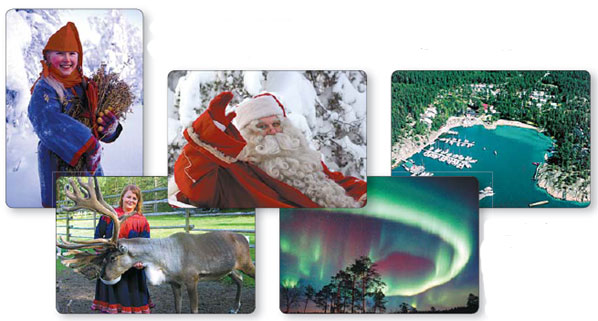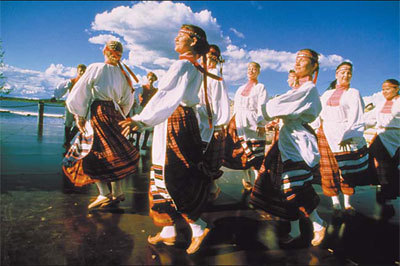Finland observes 90th anniversary
|
Finnish folk dancers in national costume |
Finland gained independence on December 6, 1917. The Parliament Act adopted in 1906 created Finnish democracy: universal suffrage gave all adult Finns the right to vote and stand for election.
The logo ME! (WE!) of the 90th anniversary year refers to the full range of 'Finnishness'-original Finns, historical minorities, newcomer Finns and expatriates.
Over the centuries, Finns have developed the Finnish way of life, which they are now celebrating.
With the WE! spirit, Finland has gone from strength to strength. The anniversary logo encourages all Finns to continue working and doing together.
A key aim during the year will be to undramatize Finnishness and cherish it above all as a vigorous, dynamic force looking forward to the future.
Themes
The themes of the anniversary year spring from different aspects of Finland and Finnishness. There are six themes: history and future; nature and summer; language and culture; music; design; sport and physical activity.
Numerous Finland 90 partners will arrange activities and events around the themes.
Joyous Quarter
On the eve of Independence Day, on December 5, all of Finland dedicated a moment to celebrate their independence.
This "Joyous Quarter for Independent Finland" gave every Finn and friends of Finland a shared experience of independence celebrations.
The Joyous Quarter is an anniversary celebration with a difference: it is a festive rather than a solemn event. Everyone celebrated wherever they were at that moment: at school, at work, at home, at an old-age home, at a day-care center, in a car, in the street, in a shop, in the market place.
There were certain shared elements in the Joyous Quarter, such as a congratulatory song to Finland. It is also reported that each community arranged a program of its own.
90-year-old independent state
At the beginning of 2007, there were 193 independent states in the world. Finland is the 54th oldest among them, and belongs to the oldest third of all states.
Most of the current states are younger than 50 years old, and the majority of them gained independence only after the Second World War during the 1960s, 1970s and 1990s.
Change in industrial structure
When Finland gained its independence, it had a population of 3.1 million people. Now, 90 years on, the Finnish population numbers 5.3 million.
The population structure is, however, radically different as decreasing births lower the number of children and longer life expectancy adds to the number of elderly people.
Radical changes are also visible in the industrial structure. In the early 20th century, Finland was an entirely agricultural society, whereas now they live in a post-industrial society based on services.
Growing years of Finland's industrial production
Throughout Finland's independence, industrial production has been a vital factor contributing to economic growth in the country.
Between 1925 and 2006, Finland's industrial output went up by an average of five percent per year despite the fact that the period contained the Second World War and two economic recessions.
Up to the beginning of the 2000s, the country's industrial output grew considerably faster than its total output.
The growth of Finland's industrial output has clearly exceeded the average respective growth in other industrialized countries.
From villa ownership to national leisure-time activity
The construction of summer villas started in Finland already in the 19th century, but during the early years of Finnish independence, villa life was attainable only for a select few.
In those days there were roughly 3,000 villas in Finland. Spending time at the summer cottage became a pastime for the entire population only in the 1950s.
At the end of 2006 there were nearly half a million summer cottages in Finland.
Consumption growth
Finns consume 11 times more now than 100 years ago
Present-day Finns acquire 11 times more goods and services than the Finns of the first half of the previous century.
During the same period, the structure of consumption has changed entirely.
In the early years of Finnish independence, 88 percent of private consumption was made up of food, beverages, tobacco, clothing, housing and housewares.
Alongside the rise in the standard of living, the share of physical exercise, leisure time, travel and other expenditure has grown to nearly one half of total consumption expenditure.
From hand-cranked connections to hands-free mobile calls
Despite their reputation of being reticent, the Finns have been among the forerunners in the world in the use of the telephone.
The first telephone line was erected in Helsinki towards the end of 1877; only 18 months after the telephone had been patented in the United States.
Mobile phones, too, made their penetration in Finland much earlier and more quickly than in any other country in the world.
A century of motoring in Finland
The history of motoring started in Finland in the year 1900 when the first passenger cars were bought into the country.
At the end of 2006, there were nearly three million automobiles in Finland and a total of 52.2 billion kilometers were driven with them.
Photographs and text are supplied by the Finnish Tourist Board.

(China Daily 12/06/2007 page23)















